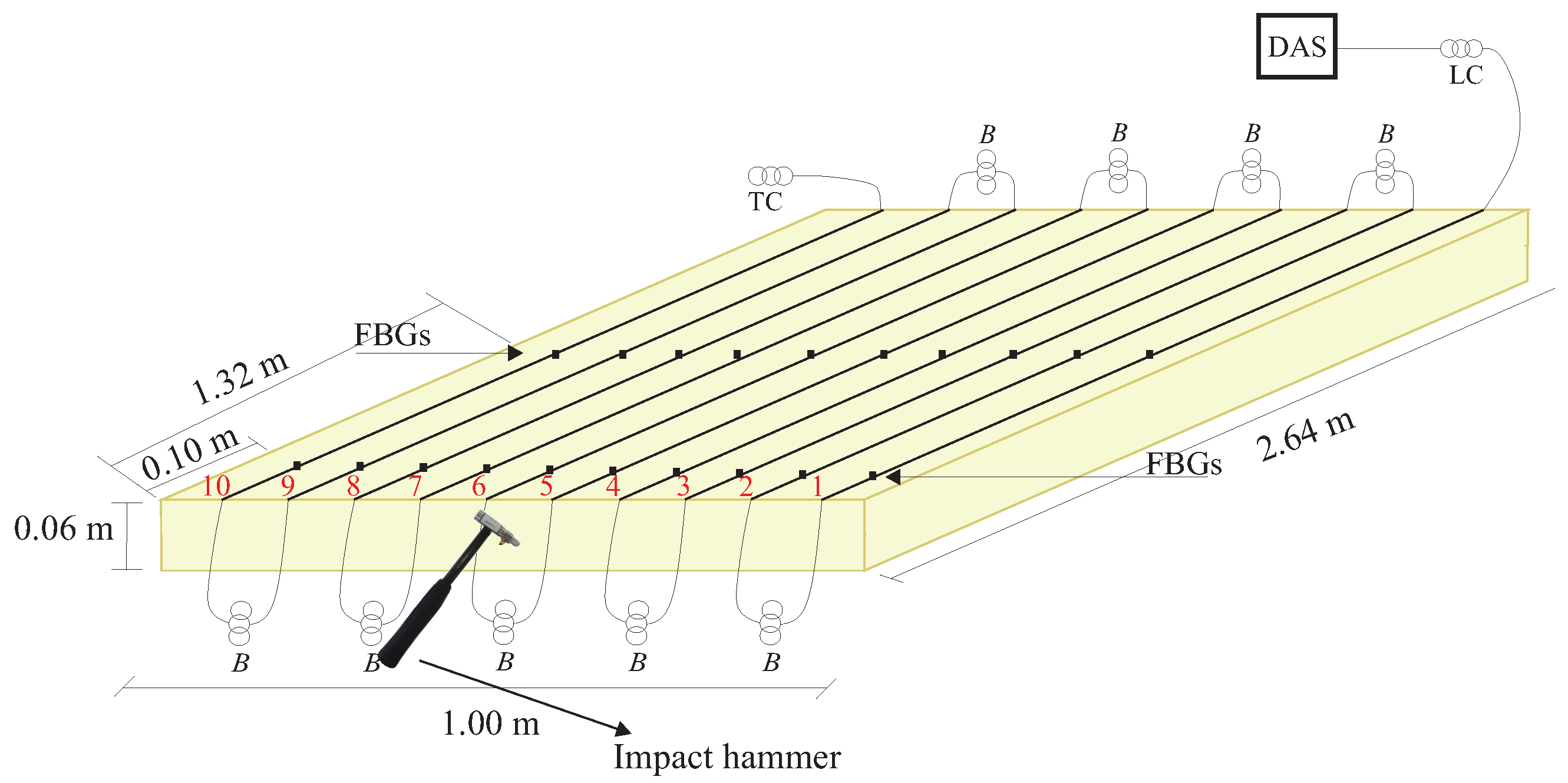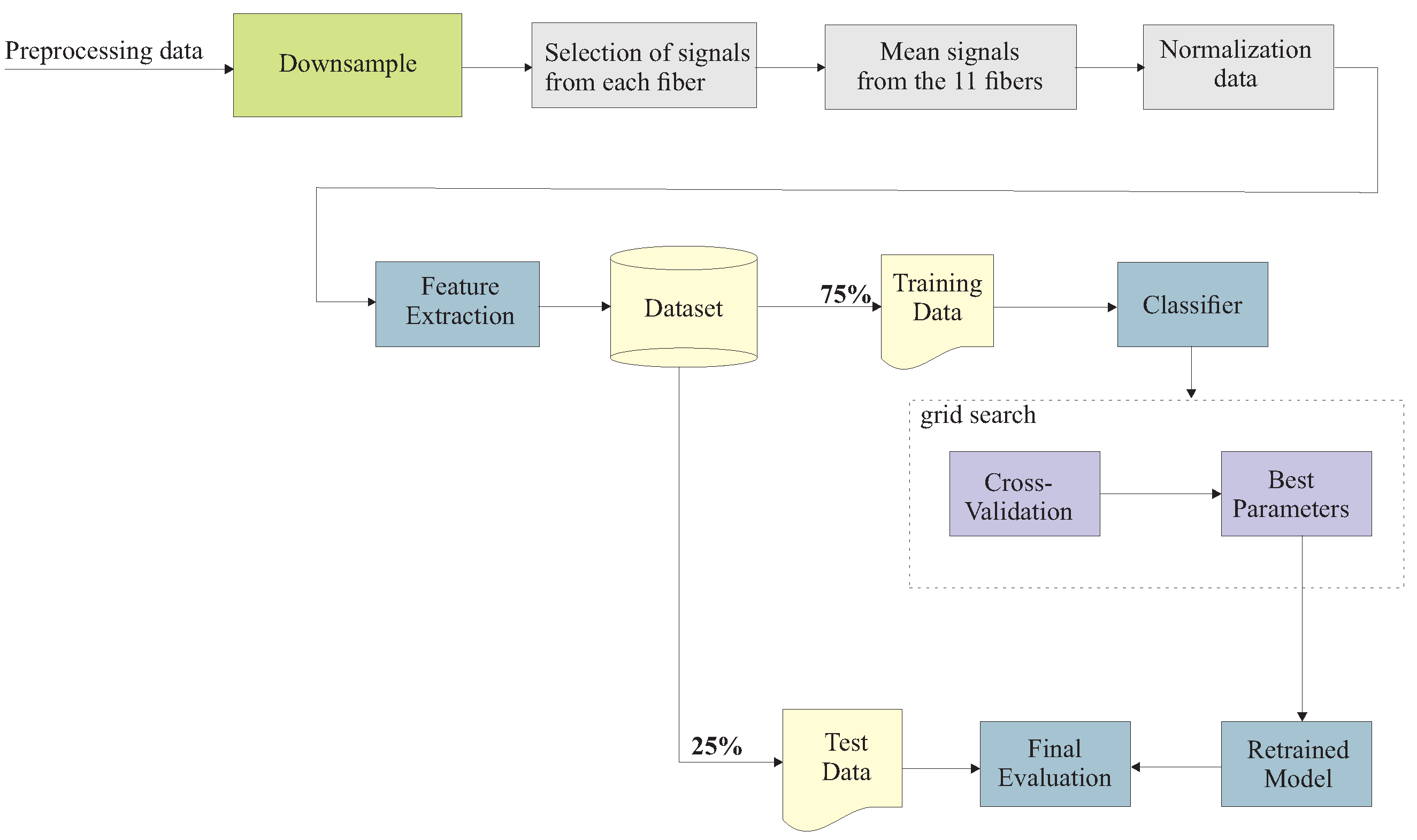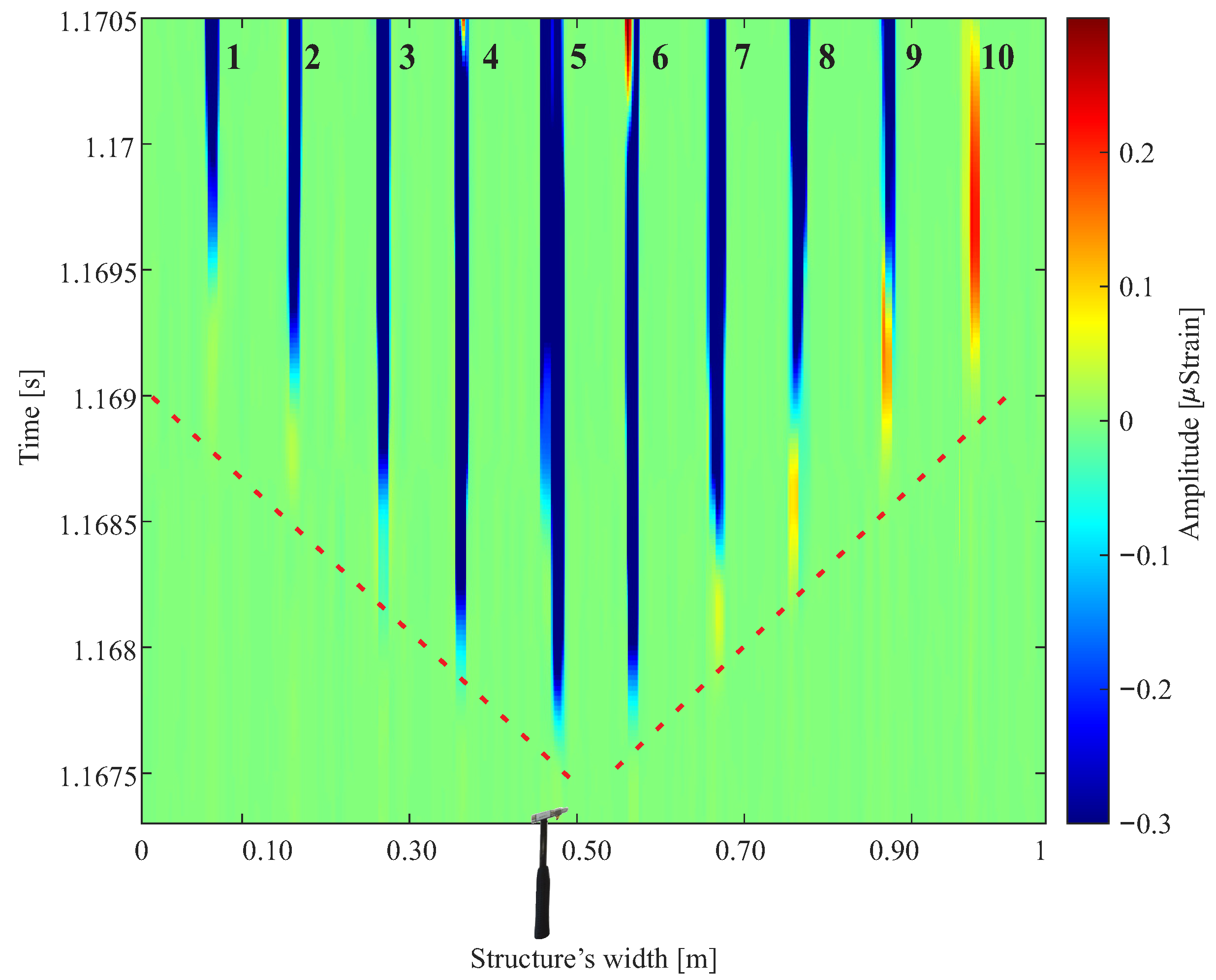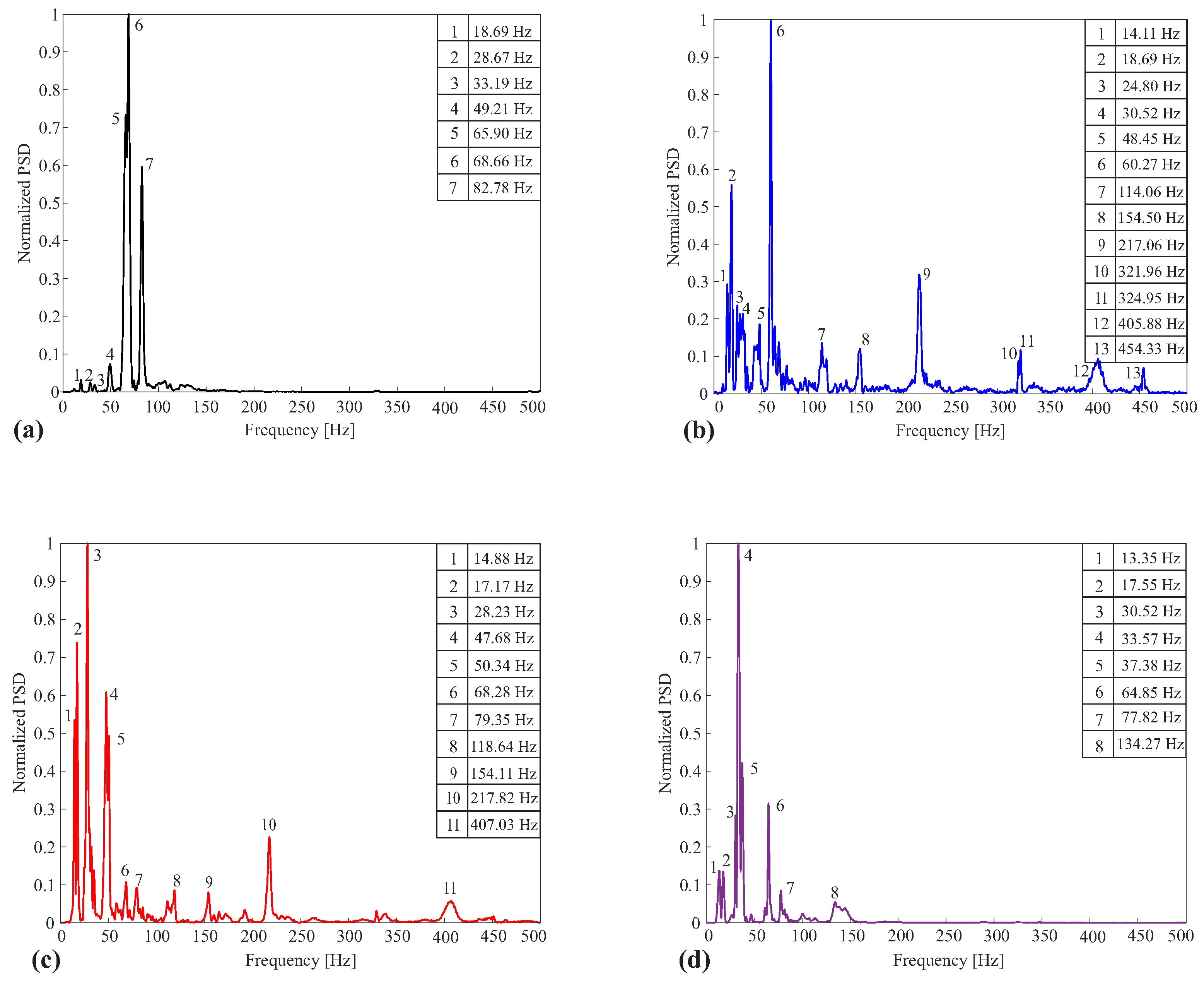Multilayer Structure Damage Detection Using Optical Fiber Acoustic Sensing and Machine Learning
Abstract
:1. Introduction
2. Materials and Methods
2.1. Experimental Setup for Mechanical Wavefront Analyses
2.2. Multilayer Experimental Setup
3. Results and Discussion
3.1. Detection of the Mechanical Wavefront
3.2. Discontinuities Analysis in Multilayer Structures
4. Conclusions
Author Contributions
Funding
Data Availability Statement
Acknowledgments
Conflicts of Interest
References
- Cawley, P. Structural health monitoring: Closing the gap between research and industrial deployment. Struct. Health Monit. 2018, 17, 1225–1244. [Google Scholar] [CrossRef]
- David-West, O.; Amafabia, D.; Haritos, G.; Montalvao, D. A review of structural health monitoring techniques as applied to composite structures. Struct. Durab. Health Monit. 2017, 11, 91–147. [Google Scholar]
- Soman, R.; Wee, J.; Peters, K. Optical fiber sensors for ultrasonic structural health monitoring: A review. Sensors 2021, 21, 7345. [Google Scholar] [CrossRef] [PubMed]
- Amezquita-Sanchez, J.P.; Adeli, H. Signal processing techniques for vibration-based health monitoring of smart structures. Arch. Comput. Methods Eng. 2016, 23, 1–15. [Google Scholar] [CrossRef]
- Gattulli, V.; Lepidi, M.; Potenza, F. Dynamic testing and health monitoring of historic and modern civil structures in Italy. Struct. Monit. Maint. 2016, 3, 71. [Google Scholar] [CrossRef]
- Majumder, M.; Gangopadhyay, T.K.; Chakraborty, A.K.; Dasgupta, K.; Bhattacharya, D.K. Fibre Bragg gratings in structural health monitoring—Present status and applications. Sens. Actuators Phys. 2008, 147, 150–164. [Google Scholar] [CrossRef]
- Jayawickrema, U.; Herath, H.; Hettiarachchi, N.; Sooriyaarachchi, H.; Epaarachchi, J. Fibre-optic sensor and deep learning-based structural health monitoring systems for civil structures: A review. Measurement 2022, 199, 111543. [Google Scholar] [CrossRef]
- Campanella, C.E.; Cuccovillo, A.; Campanella, C.; Yurt, A.; Passaro, V.M. Fibre Bragg grating based strain sensors: Review of technology and applications. Sensors 2018, 18, 3115. [Google Scholar] [CrossRef]
- Ghimire, M.; Wang, C.; Dixon, K.; Serrato, M. In situ monitoring of prestressed concrete using embedded fiber loop ringdown strain sensor. Measurement 2018, 124, 224–232. [Google Scholar] [CrossRef]
- Wu, T.; Liu, G.; Fu, S.; Xing, F. Recent progress of fiber-optic sensors for the structural health monitoring of civil infrastructure. Sensors 2020, 20, 4517. [Google Scholar] [CrossRef]
- Bao, X.; Chen, L. Recent progress in Brillouin scattering based fiber sensors. Sensors 2011, 11, 4152–4187. [Google Scholar] [CrossRef] [PubMed]
- Karapanagiotis, C.; Schukar, M.; Krebber, K. Distributed fiber optic sensors for structural health monitoring of composite pressure vessels. tm-Tech. Mess. 2024, 91, 168–179. [Google Scholar] [CrossRef]
- Lu, P.; Lalam, N.; Badar, M.; Liu, B.; Chorpening, B.T.; Buric, M.P.; Ohodnicki, P.R. Distributed optical fiber sensing: Review and perspective. Appl. Phys. Rev. 2019, 6, 041302. [Google Scholar] [CrossRef]
- Glisic, B.; Inaudi, D. Development of method for in-service crack detection based on distributed fiber optic sensors. Struct. Health Monit. 2012, 11, 161–171. [Google Scholar] [CrossRef]
- Lee, B. Review of the present status of optical fiber sensors. Opt. Fiber Technol. 2003, 9, 57–79. [Google Scholar] [CrossRef]
- Rodet, J.; Tauzin, B.; Amin Panah, M.; Guéguen, P.; Nziengui Bâ, D.; Coutant, O.; Brûlé, S. Urban dark fiber distributed acoustic sensing for bridge monitoring. Struct. Health Monit. 2024. [Google Scholar] [CrossRef]
- Hull, J.; Gosselin, L.; Borzel, K. Well integrity monitoring & analysis using distributed acoustic fiber optic sensors. In Proceedings of the SPE/IADC Drilling Conference and Exhibition, New Orleans, LA, USA, 2–4 February 2010; SPE: New Orleans, LA, USA, 2010; p. SPE-128304. [Google Scholar]
- Hartog, A.; Frignet, B.; Mackie, D.; Clark, M. Vertical seismic optical profiling on wireline logging cable. Geophys. Prospect. 2014, 62, 693–701. [Google Scholar] [CrossRef]
- Wagner, A.; Nash, A.; Michelberger, F.; Grossberger, H.; Lancaster, G. The effectiveness of distributed acoustic sensing (DAS) for broken rail detection. Energies 2023, 16, 522. [Google Scholar] [CrossRef]
- Zhang, T.Y.; Shi, B.; Zhang, C.C.; Xie, T.; Yin, J.; Li, J.P. Tunnel disturbance events monitoring and recognition with distributed acoustic sensing (DAS). In Proceedings of the ISRM International Symposium—Asian Rock Mechanics Symposium, Beijing, China, 21–25 October 2021; ISRM: Beijing, China, 2021; pp. 1–8. [Google Scholar]
- Urquijo, I.R.; García, A.C.; Cobo, L.R.; Incera, M.Á.Q. Real options of distributed DAS sensing applied to road transport engineering. Transp. Res. Procedia 2023, 71, 323–330. [Google Scholar] [CrossRef]
- Stork, A.; Mordret, A.; Beaupretre, S.; Johansson, S. Distributed Acoustic Sensing (Das) for Detection of Defects in Dams Using Ambient Noise Interferometry. In Proceedings of the NSG2022 28th European Meeting of Environmental and Engineering Geophysics, Belgrade, Serbia, 18–22 September 2022; European Association of Geoscientists & Engineers: Berne, Switzerland, 2022; Volume 2022, pp. 1–5. [Google Scholar]
- Nolet, G.; Dahlen, F. Wave front healing and the evolution of seismic delay times. J. Geophys. Res. Solid Earth 2000, 105, 19043–19054. [Google Scholar] [CrossRef]
- Dong, B.; Popescu, A.; Tribaldos, V.R.; Byna, S.; Ajo-Franklin, J.; Wu, K. Real-time and post-hoc compression for data from Distributed Acoustic Sensing. Comput. Geosci. 2022, 166, 105181. [Google Scholar] [CrossRef]
- Shiloh, L.; Eyal, A.; Giryes, R. Deep learning approach for processing fiber-optic DAS seismic data. In Proceedings of the Optical Fiber Sensors; Optica Publishing Group: Lausanne, Switzerland, 2018; p. ThE22. [Google Scholar]
- Sonbul, O.S.; Rashid, M. Algorithms and techniques for the structural health monitoring of bridges: Systematic literature review. Sensors 2023, 23, 4230. [Google Scholar] [CrossRef]
- Heim Weber, G.; Santos, E.N.d.; Gomes, D.F.; Santana, A.L.B.; Silva, J.C.C.d.; Martelli, C.; Pipa, D.R.; Morales, R.E.M.; de Camargo Júnior, S.T.; da Silva Junior, M.F.; et al. Measurement of Gas-Phase Velocities in Two-Phase Flow Using Distributed Acoustic Sensing. IEEE Sens. J. 2023, 23, 3597–3608. [Google Scholar] [CrossRef]
- Itoh, K. Analysis of the phase unwrapping algorithm. Appl. Opt. 1982, 21, 2470. [Google Scholar] [CrossRef] [PubMed]
- Sagues, M.; Piñeiro, E.; Cerri, E.; Minardo, A.; Eyal, A.; Loayssa, A. Two-wavelength phase-sensitive OTDR sensor using perfect periodic correlation codes for measurement range enhancement, noise reduction and fading compensation. Opt. Express 2021, 29, 6021–6035. [Google Scholar] [CrossRef]
- Omer, A.A.; Hassan, O.I.; Ahmed, A.I.; Abdelrahman, A. Denoising CT Images using Median based Filters: A Review. In Proceedings of the 2018 International Conference on Computer, Control, Electrical, and Electronics Engineering (ICCCEEE), Khartoum, Sudan, 12–14 August 2018; pp. 1–6. [Google Scholar] [CrossRef]
- SEAFOM. Measuring Sensor Performance Document (SEAFOM MSP-02)—DAS Parameter Definitions and Tests. 2018. Available online: https://seafom.com/published-documents/ (accessed on 28 July 2024).
- Barandas, M.; Folgado, D.; Fernandes, L.; Santos, S.; Abreu, M.; Bota, P.; Liu, H.; Schultz, T.; Gamboa, H. TSFEL: Time series feature extraction library. SoftwareX 2020, 11, 100456. [Google Scholar] [CrossRef]
- Vapnik, V. The Nature of Statistical Learning Theory; Springer Science & Business Media: New York, NY, USA, 1999. [Google Scholar]
- Diamantidis, N.; Karlis, D.; Giakoumakis, E. Unsupervised stratification of cross-validation for accuracy estimation. Artif. Intell. 2000, 116, 1–16. [Google Scholar] [CrossRef]
- Syarif, I.; Prugel-Bennett, A.; Wills, G. SVM parameter optimization using grid search and genetic algorithm to improve classification performance. Telkomnika 2016, 14, 1502. [Google Scholar] [CrossRef]
- Salawu, O.S. Detection of structural damage through changes in frequency: A review. Eng. Struct. 1997, 19, 718–723. [Google Scholar] [CrossRef]
- Goodman, J.W. Statistical optics. J. Opt. Soc. Am. A 1985, 2, 68–70. [Google Scholar] [CrossRef]
- Kulpa, M.; Howiacki, T.; Wiater, A.; Siwowski, T.; Sieńko, R. Strain and displacement measurement based on distributed fibre optic sensing (DFOS) system integrated with FRP composite sandwich panel. Measurement 2021, 175, 109099. [Google Scholar] [CrossRef]











| Predicted Class | |||||
| True class | Undamaged | 11 | 0 | 0 | 0 |
| Air Discontinuity | 0 | 8 | 3 | 0 | |
| Water Discontinuity | 0 | 0 | 9 | 2 | |
| Crack in MDF | 0 | 0 | 1 | 7 | |
| Undamaged | Air | Water | Crack | ||
| Predicted Class | ||||
| True class | Undamaged | 4 | 0 | 0 |
| Air Discontinuity | 0 | 5 | 0 | |
| Water Discontinuity | 1 | 0 | 4 | |
| Undamaged | Air | Water | ||
Disclaimer/Publisher’s Note: The statements, opinions and data contained in all publications are solely those of the individual author(s) and contributor(s) and not of MDPI and/or the editor(s). MDPI and/or the editor(s) disclaim responsibility for any injury to people or property resulting from any ideas, methods, instructions or products referred to in the content. |
© 2024 by the authors. Licensee MDPI, Basel, Switzerland. This article is an open access article distributed under the terms and conditions of the Creative Commons Attribution (CC BY) license (https://creativecommons.org/licenses/by/4.0/).
Share and Cite
Brusamarello, B.; Dreyer, U.J.; Brunetto, G.A.; Pedrozo Melegari, L.F.; Martelli, C.; Cardozo da Silva, J.C. Multilayer Structure Damage Detection Using Optical Fiber Acoustic Sensing and Machine Learning. Sensors 2024, 24, 5777. https://doi.org/10.3390/s24175777
Brusamarello B, Dreyer UJ, Brunetto GA, Pedrozo Melegari LF, Martelli C, Cardozo da Silva JC. Multilayer Structure Damage Detection Using Optical Fiber Acoustic Sensing and Machine Learning. Sensors. 2024; 24(17):5777. https://doi.org/10.3390/s24175777
Chicago/Turabian StyleBrusamarello, Beatriz, Uilian José Dreyer, Gilson Antonio Brunetto, Luis Fernando Pedrozo Melegari, Cicero Martelli, and Jean Carlos Cardozo da Silva. 2024. "Multilayer Structure Damage Detection Using Optical Fiber Acoustic Sensing and Machine Learning" Sensors 24, no. 17: 5777. https://doi.org/10.3390/s24175777





